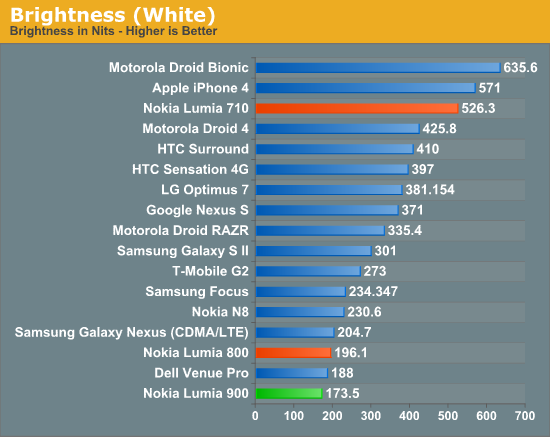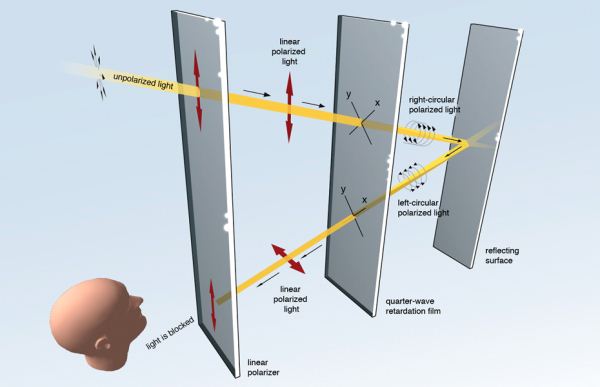Nokia Lumia 900 Review - Windows Phone with LTE
by Brian Klug on April 3, 2012 9:00 PM ESTDisplay Quality
Like the Lumia 800, the Lumia 900 uses an AMOLED display instead of an LCD. One of the chief differentiators between the two models however is the difference in subpixel rendering. Whereas the Lumia 800 used a 3.7“ PenTile RGBG SAMOLED panel, the Lumia 900 uses a 4.3” SAMOLED+ panel with an RGB subpixel stripe. Those names fit, that is, if we’re following Samsung’s naming scheme, and as an aside this is undoubtedly a Samsung panel.
The effective resolution of both displays are 800x480 WVGA, like all Windows Phones, however. Jumping up in display size pretty much necessitates that change to RGB, since PenTile really only works when subpixels are below human visual acuity. In addition, we’ve already seen 4.3" SAMOLED+ WVGA displays out of Samsung (see the Focus S).
I measured the Lumia 900 display using an i1D2 just like I’ve done with numerous other smartphones, though at this point the advanced color and gamut information will have to wait until I make some targets. Again, because AMOLED is emissive, black color pixels are literally off, so contrast graphs are omitted. The Lumia 900 doesn’t go super bright, like other AMOLEDs I’ve seen. In fact, it’s slightly dimmer than the Lumia 800’s maximum of 196 nits. Remember that going to a larger display, especially AMOLED due to its emissive nature, increases power demands as r^2 since we’re talking about areal size.
| Lumia 900 Display Metrics | |||
| Brightness Level | Black Brightness (nits) | White Brightness (nits) | White Point (K) |
| Low | 0 | 72.68 | 6635 |
| Medium | 0 | 140.06 | 6930 |
| High | 0 | 173.55 | 6812 |
Nokia was able to get the Lumia 900 display nice and close to 6500K, which is interesting considering how many other AMOLED displays I’ve seen which are up near 8000K or higher and noticeably blue all the time.

I glossed over ClearBlack on the previous Lumia reviews partly due to time constraints, partly due to not knowing the exact details of their optical path. That said, it was immediately obvious that the system used circular polarization’s behavior upon reflection to attenuate back reflections. However, since writing those reviews, Nokia has outlined their optical system in a conversations post, and the long and short of it is that the system consists of a linear polarizer and quarter-wave plate.
Incoming diffuse light gets vertically polarized by a surface polarizer, which becomes right hand circularly polarized when passing through the quarter wave plate. When circular polarized reflects off of a surface, it changes handedness - in this case from right to left handed circular. Upon passing through the quarter wave plate on its way out, this becomes horizontally polarized, which is then strongly attenuated by the surface polarizer with its fast axis aligned vertically on its way out, which acts like an analyzer. The end result is that outdoors the only reflection you’ll get is from the first surface, not the surface of the display itself, which does reduce resulting glare.
This change also permits the Lumia 900 to still look bright outside, and in turn allows Nokia to run the display at a lower brightness and save some amount of power. For a while I was waiting for some OEM to introduce a system using polarization to diminish back reflections, and Nokia has done it with ClearBlack.
Indoor viewing angles for the Lumia 900 are excellent as evidenced by the purple test pattern from WP Bench not changing color at extreme field angles. In addition, I subjectively can’t find any issues with the display - there are none of the other problems that affect the higher dot pitch AMOLEDs such as grain or mura. Outdoor viewing angles are likewise good for the Lumia 900 in part thanks to ClearBlack.

















128 Comments
View All Comments
UltraTech79 - Saturday, April 7, 2012 - link
Also, no most people do NOT like the design, else they would be buying these and not Droids/iPhones by the truckload.jmcb - Tuesday, April 10, 2012 - link
To me battery life on WP7 has never been as great as many claim since WP7 launched. I usually reference this site for results, debates.Battery life is part of my deal breakers for any phone.
gamoniac - Tuesday, April 3, 2012 - link
[quoteThe article: ]...the only major gripes I have with Nokia Drive are that the application arguably should change between night and daytime map colors automatically...[/quote]I checked out this feature at the store, I think WP7 should let you decide whether to let the map color or to set it to manual mode. Some people might find the daylight map easier to read during the night.
vision33r - Tuesday, April 3, 2012 - link
Well, in general if Android doesn't suck so much none of us really need a quad-core phone. Clearly WP is much more efficient platform than Android today so a single-core phone can be this solid and for most people this translates to feeling faster than most Android phones that lags when apps are running and sans performance.Nearly every Android device I've used today needs manual management in order to run smoothly. Letting a single widget or app sitting background too long, battery life and performance suffers. Android's entire ecosystem is to blame for faulty app coding to OS builds rigged with bloatware.
This is a refreshing device, hopefully people will not care about the specs and embrace efficiency and good hardware and software designs.
gamoniac - Tuesday, April 3, 2012 - link
I totally agree. I am held back from jumping on a WP7 for two reasons: WP8 is coming and a dual-core WP would be great.I respect AnandTech's spirit of journalism that makes it stand out among review sites. At the same time, I wonder if there is a fair way to rate the phone based on total user experience, in a somewhat quantifiable way, as opposed to core count or a simple opinion. Perhaps a weighted score of each of the categories, although that could still be subjective. Perhaps a short video review? Maybe some AT readers have some brilliant ideas to share.
davepermen - Wednesday, April 4, 2012 - link
a total user experience rating?here it is:
always smooth, always instant, never stuttering.
why should I care about "faster hardware" if the phone is already perfoming at it's best possible speed?
this rating is based on the lumia 800 i own.
i've yet to find an android phone as smooth and fast as the lumia 800.
i can't wait for apollo, out of the curiosity of what's all in there, and all those tiny features that a win8 kernel brings (WPS for Wifi connection, for example, proper windows updates, etc).
but at no point i wait for apollo to "get a fast phone". because i already have that.
french toast - Wednesday, April 4, 2012 - link
Yes good point..its efficient and fast..but too be honst Meego and even Symbian is even faster still..running on even worse hardware than this....The point is smoothness and efficiency is great...brilliant, but what about things like batterylife? HD displays? powerfull apps and GAMES?? 1080p video recording and editing?? True multitasking?? its not all just about sending a few emails, checking facebook, and floating around in the opererating system...on android and ios you can do soo much more than that...the apps are much better..and the games are just not possible at smooth frame rates on that crappy Snapdragon.
About the efficiency...you realise that now ICSv 4 has been released and Tegra 3/Snapdragon S4 have been loaded...that lag is a non issue anymore??
Even with giant HD display...and the resource hungry Sense overlay..a mobile phone has NEVER looked so good and been so slick..WHILST DOING COMPLICATED THINGS (thats the kicker that seperates a SMARTPHONE from FEATURE PHONE)
For the record im not anti Nokia or anti microsoft..im a fan of both..and will be buying WP8...this is actually the first WP7 device that i would own...as Anand says, considering the 1 year to get this from design to market..and considering the crap components Nokia has to work with..this Nokia 900 is a revelation..Can't wait till Q4 ;)
For a comparison..this is what a modern Android SMARTPHONE is comapred to the best WP7 has to offer;
HTC ONE X REVIEW PT1;
http://www.youtube.com/watch?v=gotEbvgu9ms
PT2
http://www.youtube.com/watch?v=p4LQXtV5z0Q&fea...
Note, that despite hulking around a massive 4.7 HD screen, a quad core tEGRA 3 processor 1gb ram..and the same size battery..the ONE X likely gets much better batterylife than this Lumia 900...(after the OTA firmware update, early reviews had average battery because of this)
gamoniac - Wednesday, April 4, 2012 - link
Those are great review videos. Thanks for the links. HTC One X is quite an impressive piece of device, I must say. As an android user who is not so happy, I can see that ICS has improved quite a bit.leexgx - Friday, April 6, 2012 - link
still the hardware requirement to make it smooth is very bad for android, Tegra 3 + android = smooth , any thing els is hit or missevery thing on windows 7 phones are GPU driven so no lag due to that and the basic hardware is set quite high (but users thing its low not sure what Dual core win7phones will do), compared to android where any thing goes so you end up with lackluster phones when they should not be even when they are dual core or higher as most apps are not GPU driven they can stall and make the phone laggy (Slow NAND as well i see a lot on android as well)
when my phone contract runs out i most likely get an windows phone as i need the calendar cant use the one quickly on android (i have always used an windows Mobile device before, i broke the screen on my last one and ended up with an 8520 as an test then 9870 as i got used and liked it, but i do prefer windows phones)
sonicmerlin - Saturday, April 7, 2012 - link
HTC One X doesn't get better battery life. You missed the line where Brian states subjectively the battery life of the Lumia 900 is much better than the tests suggest.One of the aggravations of Android is that standby drains huge amounts of battery. Leaving radios on, having widgets running in the background, keeping data and background sync on, etc. drain your battery like a fiend even while your phone is on standby.
WP7 and iOS don't suffer from these issues (iOS fixed them in firmware 5.1, Nokia fixed them after 5 firmware updates to the Lumia 800), and over the course of a day will last you much, much longer than any Android phone.